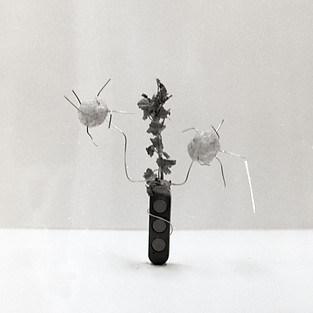College Projects
Trash Bouquets
Waste Herbarium
Consumption Cycle
My photography series explores the unexpected beauty in urban neglect by combining discarded litter and wildflowers gathered from Morgantown's streets. Each Trash Bouquet presents a striking visual contradiction: delicate natural blooms emerging from consumer waste. Captured in black and white, these images strip away preconceptions and invite viewers to reconsider what we categorize as beautiful or worthless.
The stark monochromatic treatment lends these spontaneous compositions a timeless, documentary quality.Each Trash Bouquet captures a conversation between things we thoughtlessly discard and the wildflowers we rarely stop to notice. Working in black and white helps me strip away the distractions and focus on these unexpected relationships.
My work creates a visual tension that challenges viewers to confront their own consumption habits. It also makes you wonder: What becomes visible when we truly look at what surrounds us? How might beauty persist in unexpected places? These compositions transform overlooked street corners into sources of unexpected grace and thoughtful reflection on our throwaway culture.
My "Waste Herbarium" series represents the first project in my exploration of pseudo-botanical specimens. Documenting the afterlife of food waste through carefully constructed compositions. Using discarded food items destined for trash bins, I meticulously arrange and photograph these remnants as if they were precious botanical specimens worthy of scientific study and preservation.
Rendered in stark black and white to evoke traditional botanical archives, these compositions transform the familiar into the strange. The monochromatic photos strips away the repulsive qualities we associate with food waste, allowing viewers to see beauty in what we typically discard without thought.
By positioning waste as subject rather than byproduct, "Waste Herbarium" questions the boundaries between valuable and worthless. The taxonomic presentation suggests these compositions deserve the same careful documentation as rare plant specimens, creating tension between scientific objectivity and the emotional response to decay.
As the first iteration in my ongoing pseudo-botanical series, this project established my methodology of transforming overlooked materials into specimens of contemplation. Giving waste this deliberate composition, I invite viewers to reconsider their relationship with food, what we consume, what we discard, and how quickly we forget what we've thrown away.
My photography series explores the coexistence of technology and nature by combining discarded electronics, expired food, and plant matter into pseudo-botanical specimens. Deliberately captured in black and white film to evoke scientific documentation, these images present strange new life forms as visual metaphors for our wasteful habits and nature's persistence.
Thin wires mimic plant stems, suggesting both vulnerability and resilience. The work presents two possible futures: one where our trash overwhelms the natural world, another where nature adapts and incorporates our technological remnants. When constructing electrical components into plant forms, I'm questioning: Will technology consume nature, or will nature eventually reclaim everything we create?
The title "Consumption Cycle" references both our endless loop of buying, using, and discarding, and nature's cycles of growth and decay. These opposing forces increasingly converge as the boundary between natural and artificial worlds blurs. My work invites viewers to confront their own relationship with consumption while contemplating nature's remarkable adaptability.


